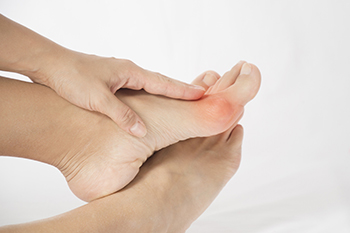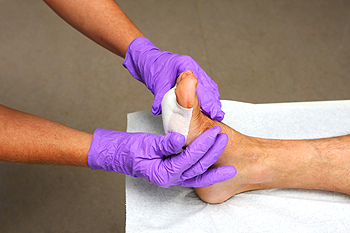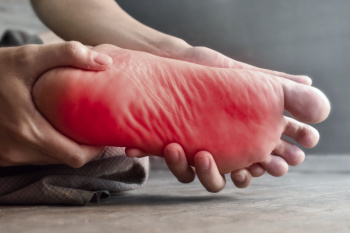Items filtered by date: August 2025
Managing Bunions

Bunions are a foot condition where the top of the big toe angles toward the second toe, and a bony bump forms at the base of the big toe. They often develop due to genetics, wearing tight or narrow shoes, arthritis, or foot stress. Symptoms include redness, swelling, and soreness surrounding the joint, as well as pain while walking or wearing shoes. The skin over the bunion may become thick and callused, and the toe can become stiff or difficult to move. Bunions can worsen over time, if left untreated, leading to increased discomfort and changes in foot shape. A podiatrist can diagnose a bunion through a physical exam and X-rays to assess its severity. Treatment includes custom orthotics, footwear changes, anti-inflammatory medication, and, in more severe cases, surgery to realign the joint. Early care can prevent further progression and ease discomfort. If you have a painful bunion, it is suggested that you schedule an appointment with a podiatrist for effective relief and treatment solutions.
If you are suffering from bunion pain, contact David K. Morris, DPM of Florida. Our doctor can provide the care you need to keep you pain-free and on your feet.
What Is a Bunion?
Bunions are painful bony bumps that usually develop on the inside of the foot at the joint of the big toe. As the deformity increases over time, it may become painful to walk and wear shoes. Women are more likely to exacerbate existing bunions since they often wear tight, narrow shoes that shift their toes together. Bunion pain can be relieved by wearing wider shoes with enough room for the toes.
Causes
- Genetics – some people inherit feet that are more prone to bunion development
- Inflammatory Conditions - rheumatoid arthritis and polio may cause bunion development
Symptoms
- Redness and inflammation
- Pain and tenderness
- Callus or corns on the bump
- Restricted motion in the big toe
In order to diagnose your bunion, your podiatrist may ask about your medical history, symptoms, and general health. Your doctor might also order an x-ray to take a closer look at your feet. Nonsurgical treatment options include orthotics, padding, icing, changes in footwear, and medication. If nonsurgical treatments don’t alleviate your bunion pain, surgery may be necessary.
If you have any questions, please feel free to contact our office located in Plantation, FL . We offer the newest diagnostic and treatment technologies for all your foot care needs.
Keep Your Feet Healthy So You Can Stay Active
How Negative Pressure Helps Heal Wounds

Negative pressure wound therapy is a treatment option that can help promote healing for wounds that do not respond well to standard care, particularly those on the feet and ankles. This therapy involves sealing the wound with a special dressing made from sponge material or gauze, connected to a pump that removes fluids from the wound. This reduction in pressure encourages blood flow to the area and helps keep the wound moist, which can improve healing. It is commonly used for chronic wounds that have failed to heal after several weeks. Negative pressure wound therapy is particularly effective for large or infected wounds that cannot be closed directly. While studies suggest that this treatment may improve healing times, results can vary depending on the type and severity of the wound. If you have foot wounds that will not heal properly, it is suggested that you schedule an appointment with a podiatrist to see if negative pressure therapy is right for you.
Wound care is an important part in dealing with diabetes. If you have diabetes and a foot wound or would like more information about wound care for diabetics, consult with David K. Morris, DPM from Florida. Our doctor will assess your condition and provide you with quality foot and ankle treatment.
What Is Wound Care?
Wound care is the practice of taking proper care of a wound. This can range from the smallest to the largest of wounds. While everyone can benefit from proper wound care, it is much more important for diabetics. Diabetics often suffer from poor blood circulation which causes wounds to heal much slower than they would in a non-diabetic.
What Is the Importance of Wound Care?
While it may not seem apparent with small ulcers on the foot, for diabetics, any size ulcer can become infected. Diabetics often also suffer from neuropathy, or nerve loss. This means they might not even feel when they have an ulcer on their foot. If the wound becomes severely infected, amputation may be necessary. Therefore, it is of the upmost importance to properly care for any and all foot wounds.
How to Care for Wounds
The best way to care for foot wounds is to prevent them. For diabetics, this means daily inspections of the feet for any signs of abnormalities or ulcers. It is also recommended to see a podiatrist several times a year for a foot inspection. If you do have an ulcer, run the wound under water to clear dirt from the wound; then apply antibiotic ointment to the wound and cover with a bandage. Bandages should be changed daily and keeping pressure off the wound is smart. It is advised to see a podiatrist, who can keep an eye on it.
If you have any questions please contact our office located in Plantation, FL . We offer the newest diagnostic and treatment technologies for all your foot and ankle needs.
Heel Pain in Children

Sever’s disease is common of cause of heel pain in growing children and adolescents, as the result of inflammation of the growth plate in the heel bone. It typically occurs during growth spurts when the heel bone grows faster than surrounding muscles and tendons. Risk factors include high-impact activities like running and jumping, tight calf muscles, and wearing unsupportive footwear. Beyond heel pain, symptoms include swelling, limping, or discomfort during physical activity. A podiatrist can diagnose the condition, recommend stretching exercises, and suggest activity modifications, supportive footwear, or orthotics to relieve pressure. If your active child experiences persistent heel pain, it is suggested that you schedule a visit with a podiatrist who can accurately diagnose and treat the condition.
Sever's disease often occurs in children and teens. If your child is experiencing foot or ankle pain, see David K. Morris, DPM from Florida. Our doctor can treat your child’s foot and ankle needs.
Sever’s Disease
Sever’s disease is also known as calcaneal apophysitis, which is a medical condition that causes heel pain I none or both feet. The disease is known to affect children between the ages of 8 and 14.
Sever’s disease occurs when part of the child’s heel known as the growth plate (calcaneal epiphysis) is attached to the Achilles tendon. This area can suffer injury when the muscles and tendons of the growing foot do not keep pace with bone growth. Therefore, the constant pain which one experiences at the back of the heel will make the child unable to put any weight on the heel. The child is then forced to walk on their toes.
Symptoms
Acute pain – Pain associated with Sever’s disease is usually felt in the heel when the child engages in physical activity such as walking, jumping and or running.
Highly active – Children who are very active are among the most susceptible in experiencing Sever’s disease, because of the stress and tension placed on their feet.
If you have any questions, please feel free to contact our office located in Plantation, FL . We offer the newest diagnostic and treatment technologies for all your foot care needs.
Diabetic Peripheral Neuropathy and Protecting Your Feet from Silent Damage

Diabetic peripheral neuropathy is a condition where prolonged high blood sugar damages the nerves, especially in the legs and feet. This nerve damage can cause tingling, burning, numbness, or sharp pain. Common causes include poorly managed diabetes, poor circulation, and prolonged elevated glucose levels. Among the risk factors are long-term diabetes, smoking, and high blood pressure. As the feet lose sensation, injuries may go unnoticed, leading to ulcers or infections. A podiatrist can detect early nerve damage, provide foot care guidance, and help prevent complications through regular screenings and protective strategies. If you experience unusual sensations or numbness in your feet, it is suggested that you visit a podiatrist for a thorough evaluation and effective relief and management tips.
Neuropathy
Neuropathy can be a potentially serious condition, especially if it is left undiagnosed. If you have any concerns that you may be experiencing nerve loss in your feet, consult with David K. Morris, DPM from Florida. Our doctor will assess your condition and provide you with quality foot and ankle treatment for neuropathy.
What Is Neuropathy?
Neuropathy is a condition that leads to damage to the nerves in the body. Peripheral neuropathy, or neuropathy that affects your peripheral nervous system, usually occurs in the feet. Neuropathy can be triggered by a number of different causes. Such causes include diabetes, infections, cancers, disorders, and toxic substances.
Symptoms of Neuropathy Include:
- Numbness
- Sensation loss
- Prickling and tingling sensations
- Throbbing, freezing, burning pains
- Muscle weakness
Those with diabetes are at serious risk due to being unable to feel an ulcer on their feet. Diabetics usually also suffer from poor blood circulation. This can lead to the wound not healing, infections occurring, and the limb may have to be amputated.
Treatment
To treat neuropathy in the foot, podiatrists will first diagnose the cause of the neuropathy. Figuring out the underlying cause of the neuropathy will allow the podiatrist to prescribe the best treatment, whether it be caused by diabetes, toxic substance exposure, infection, etc. If the nerve has not died, then it’s possible that sensation may be able to return to the foot.
Pain medication may be issued for pain. Electrical nerve stimulation can be used to stimulate nerves. If the neuropathy is caused from pressure on the nerves, then surgery may be necessary.
If you have any questions, please feel free to contact our office located in Plantation, FL . We offer the newest diagnostic and treatment technologies for all your foot care needs.




